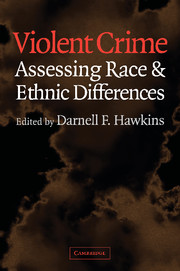Book contents
- Frontmatter
- Contents
- Contributors
- Foreword
- Editor's Introduction
- Violent Crime
- Part I Homicide Studies
- Part II Other Contexts, Settings, and Forms of Violence
- Part III Explaining Racial and Ethnic Differences
- 11 How Can the Relationship between Race and Violence be Explained?
- 12 “Race Effects” and Conceptual Ambiguity in Violence Research: Bringing Inequality Back In
- 13 The Violent Black Male: Conceptions of Race in Criminological Theories
- 14 The Structural-Cultural Perspective: A Theory of Black Male Violence
- 15 A Cultural Psychology Framework for the Study of African-American Morality and Violence
- 16 Racial Discrimination and Violence: A Longitudinal Perspective
- 17 Honor, Class, and White Southern Violence: A Historical Perspective
- References
- Index
11 - How Can the Relationship between Race and Violence be Explained?
Published online by Cambridge University Press: 22 August 2009
- Frontmatter
- Contents
- Contributors
- Foreword
- Editor's Introduction
- Violent Crime
- Part I Homicide Studies
- Part II Other Contexts, Settings, and Forms of Violence
- Part III Explaining Racial and Ethnic Differences
- 11 How Can the Relationship between Race and Violence be Explained?
- 12 “Race Effects” and Conceptual Ambiguity in Violence Research: Bringing Inequality Back In
- 13 The Violent Black Male: Conceptions of Race in Criminological Theories
- 14 The Structural-Cultural Perspective: A Theory of Black Male Violence
- 15 A Cultural Psychology Framework for the Study of African-American Morality and Violence
- 16 Racial Discrimination and Violence: A Longitudinal Perspective
- 17 Honor, Class, and White Southern Violence: A Historical Perspective
- References
- Index
Summary
Racial Differences in Violence
There is no doubt that African-American juveniles are more likely than Caucasian juveniles to be arrested for serious (index) violent offenses in the United States (homicide, forcible rape, robbery, and aggravated assault). In 1992, for example, there were sixteen arrests for index violence per 1,000 African-American juveniles, compared with 3 per 1,000 Caucasian juveniles (Snyder and Sickmund, 1995). There were 7 arrests per 1,000 African-American juveniles for robbery, compared with 0.8 for Caucasians; 8 arrests per 1,000 African-American juveniles for aggravated assault, compared with two for Caucasians; 48 arrests per 100,000 African-American juveniles for homicide, compared with six for Caucasians; and 68 arrests per 100,000 African-American juveniles for forcible rape, compared with fifteen for Caucasians (Snyder and Sickmund, 1995).
African-American: Caucasian ratios in violence are less when violence is measured by self-reports. For example, in the National Youth Survey, Elliott (1994) found that, at the peak age of seventeen, 36 percent of African-American males, 25 percent of Caucasian males, 18 percent of African-American females, and 10 percent of Caucasian females admitted to committing a serious violent offense (robbery, rape, or aggravated assault involving injury or a weapon) in the previous year. Weis (1986: 4) concluded that “among the major sociodemographic and etiological correlates of crime, only one is clearly discrepant in its correlations with self-reports and official records – race” (the present chapter focuses only on African Americans and Caucasians, not on other ethnic groups).
- Type
- Chapter
- Information
- Violent CrimeAssessing Race and Ethnic Differences, pp. 213 - 237Publisher: Cambridge University PressPrint publication year: 2003
- 37
- Cited by



